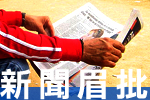HKSYU MediaLab
Welcome the Chinese
I did a double take. No way. I’d left Hong Kong and landed at the University of Maryland in College Park, and everywhere I turned there were Chinese and the familiar sounds of Mandarin being spoken. I had expected to be one of the few Chinese here or maybe even one of the few Asians.
Why the surprise? College Park, Maryland, is a suburban city about 25 minutes outside of Washington D.C. I grew up in the suburbs of New York about 40 minutes north of Manhattan, and was used to being one of the few Asians in my school and neighborhood. My friends were mostly second generation Italians and Irish who thought that Japan and China. Little wonder being in suburbia ignited images of being the lone Asian.
Since arriving on campus, I’ve swiftly learned that the number of Chinese students is substantial at the University of Maryland, there at nearly 2,000 students out of a population of some 25,000 students who are Chinese. I also learned that the majority of them are from Mainland China. The Chinese Students and Scholars Association is a large and active organization in Maryland. The university is also home to the Confucius Institute one of some 80 non-for-profit public institutions associated with the Government of the People’s Republic of China that exists to promote the Chinese culture and language.
So besides the growing number of international students in the U.S., why is Maryland such a hotspot for Mainlanders? A few of the main attractions include geography. Maryland, being in the mid-Atlantic region in the U.S., still has four seasons but isn’t as cold as New York in the winters, and it is fairly close to Washington D.C. The university is also excellent and known for both research and teaching.
At first I reacted to this reality with a sigh.
As a former resident of Hong Kong I’d become accustomed and somewhat exhausted by the growing tensions between Hong Kongers and Mainlanders. The conversations were somewhat predictable. I listened to my friends’ frustrations, many of them locals or long-time residents of Hong Kong, who pegged the growing crowds, poor air quality, pushing and shoving in shopping centric neighborhoods such as Causeway Bay on their Northern neighbors.
Upon reflection the hostility stems from both reality and perception, and as many of us know perception is reality.
In fact, the Chinese students that I’ve met here and the scholars are a delightful if not inspirational bunch. They are eager to learn about the American culture and assimilate, while maintaining their own culture and language. They show up at the casual Friday conversation hour at the Confucius Institute eager to practice their English, and open to speaking Chinese with those who want to learn. They come with the chutzpah and courage to try new things. Many of them left behind family and friends in their homeland and strike out in a new land, depending upon sheer willpower and determination. They are hungry for opportunity and a better life.
They are open to new experiences. I recently attended a Chinese church and found that a good number of the congregation were Chinese students. Admittedly Friday Bible Study was a platform to get together and be social, but they were open to learning about and discussing Christianity and The Bible and respectful of these discussions that were new to them.
The Chinese students and scholars I meet are hearty and not prone to complaint or fearful of hard work.
I still recall sitting next to a young man in his early 20s from Chongqing on the marathon plane ride from Hong Kong to the U.S. He said that after landing in New York on this 15 hour flight, he would pick up the rental car and drive about three hours to Penn State where he was studying.
“Wow, that’s rough,” I remember saying to him, trying to imagine myself doing the same. “Well, I don’t mind, it’s a really good opportunity.” In other words he sees the glass as half full. Upon reflection it was a noble trait and one that I hoped to adopt during my time on campus. #




